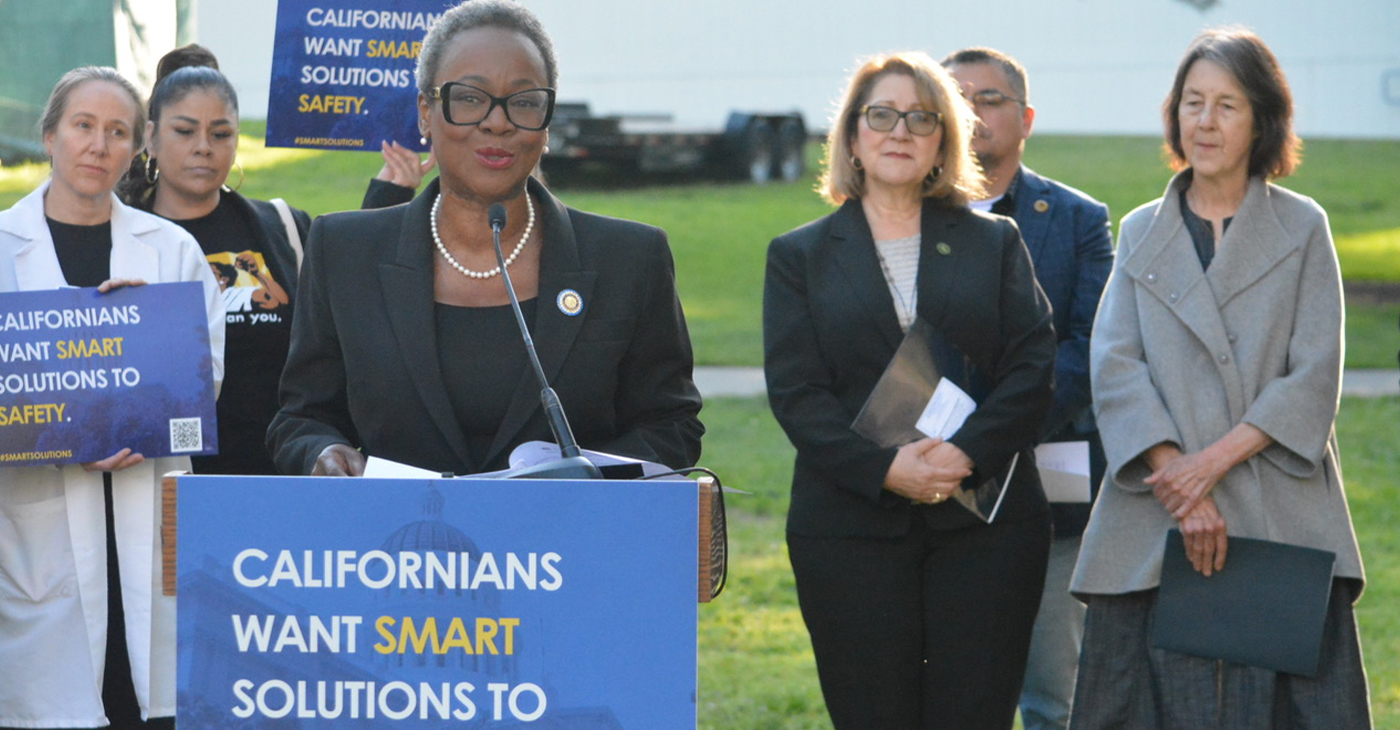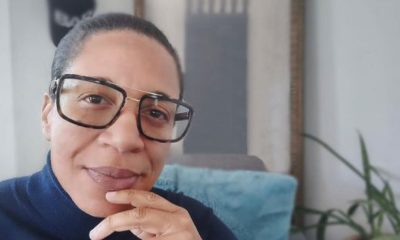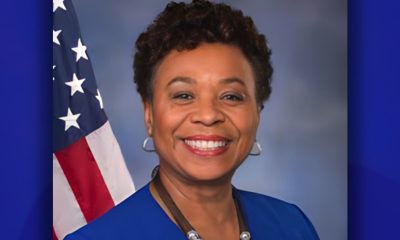Health
New Blood Tests, Liquid Biopsies, May Transform Cancer Care

Dr. Massimo Cristofanilli, oncologist and director of the Breast Care Center, speaks during an interview at Jefferson University Hospital in Philadelphia on Tuesday, April 28, 2015. With a tissue biopsy, “our treatments lag behind and they’re still based on limited information,” Cristofanilli says. With a liquid biopsy, “the power of this test has been to really find out how the disease changes, even in a short period of time.” (AP Photo/Jacqueline Larma)
MARILYNN MARCHIONE, AP Chief Medical Writer
A new type of blood test is starting to transform cancer treatment, sparing some patients the surgical and needle biopsies long needed to guide their care.
The tests, called liquid biopsies, capture cancer cells or DNA that tumors shed into the blood, instead of taking tissue from the tumor itself. A lot is still unknown about the value of these tests, but many doctors think they are a big advance that could make personalized medicine possible for far more people.
They give the first noninvasive way to repeatedly sample a cancer so doctors can profile its genes, target drugs to mutations, tell quickly whether treatment is working, and adjust it as the cancer evolves.
Two years ago, these tests were rarely used except in research. Now, several are sold, more than a dozen are in development, and some doctors are using them in routine care.
Gurpaul Bedi had one for colon cancer that spread to his lungs. About 10 percent of patients with metastatic colon cancer at the University of Texas MD Anderson Cancer Center now get liquid biopsies.
“I think it’s wonderful,” said Bedi, who lives in Atlanta and goes to Houston for his care. “A lung biopsy, many doctors told me, is not easy.”
In Philadelphia, a liquid biopsy detected Carole Linderman’s breast cancer recurrence months before it normally would have been found.
“Had this test not been available, we may not have known I had cancer on my spine until symptoms showed up,” which may have been too late for good treatment, she said.
The huge potential for these tests is clear. The problem: There are no big, definitive studies to show they help patients, how accurate they are, which type is best or who should get them and when.
Still, patients do better when drugs are matched to their tumors, and liquid biopsies may give a practical way to do that more often.
“I’m really excited about all of this,” said Dr. Razelle Kurzrock, a University of California, San Diego cancer specialist. “I spent most of my life giving drugs that were useless to people” because there was no good way to tell who would benefit or quickly tell when one wasn’t working, she said. “This is so much better.”
WHO GETS TESTED NOW
The tests are mostly used when a tissue biopsy can’t easily be done, when the cancer’s original site isn’t known, or when drugs have stopped working and doctors are unsure what to try next, said Dr. Scott Kopetz, a colon cancer specialist at MD Anderson. The tests are catching on “faster than I anticipated,” he said.
At Philadelphia’s Thomas Jefferson University, Dr. Massimo Cristofanilli has used them on about 120 breast cancer patients, including two dozen like Linderman with a high risk of recurrence.
A tissue biopsy typically samples one section of a tumor, and tumors can vary widely, with different genes and hormones active in different parts, he said. Also, cancer that has spread often differs from the original site, and tumors change rapidly in response to treatment.
With a tissue biopsy, “our treatments lag behind and they’re still based on limited information,” Cristofanilli said. With a liquid biopsy, “the power of this test has been to really find out how the disease changes, even in a short period of time.”
HOW THEY WORK
Early versions looked for whole tumor cells in blood. Newer ones look for free-floating cancer DNA, enabling gene profiling to see what mutations drive the cancer. Kopetz and Cristofanilli use one from Guardant Health Inc. of Redwood City, California, that has been sold in the U.S. since June 2014 and in parts of Europe and Asia.
Many companies are working on similar tests including Sequenom, a San Diego biotech that already sells one for prenatal screening, using fetal DNA in maternal blood. Many companies tried prenatal screening with fetal cells but it didn’t work, said chief science officer Dirk van den Boom. “Cell-free DNA really was the breakthrough” that enabled wide use, and the same could happen with these cancer tests, he said.
THE COST
Whether liquid biopsies will be cost-effective is unknown. Guardant’s test costs $5,400; some insurers cover it for certain types of patients. Gene profiling from a tissue biopsy costs about the same. The promise of liquid biopsies is that they can be done periodically to monitor care, but more tests means more cost.
They may save other costs, though. A traditional lung biopsy is thousands of dollars. Money could be saved by skipping cancer drugs that ultimately don’t work; many cost $10,000 to $15,000 a month.
With cell-free DNA tests, even doctors in rural areas can offer precision medicine because they can ship a blood sample to a lab. “We think that’s the future,” said Dr. Charles Baum, a former Pfizer cancer drug chief who now heads Mirati Therapeutics, a San Diego biotech company developing gene-targeting drugs
DO THEY WORK?
Many studies suggest that liquid biopsy results largely mirror those from tissue ones, and sometimes find more mutations. A study Kopetz presented in April at an American Association for Cancer Research meeting found the blood tests detected cancer mutations in the vast majority of 105 colorectal cancer patients. For 37 percent of them, doctors thought a drug could target a mutation that was found.
Still, no big studies show that liquid biopsies give better care or extend lives. Without that proof, how much they will be used by doctors and covered by insurers remains to be seen.
THE FUTURE
A San Diego company, Trovagene, is working on an even faster, easier liquid biopsy — a test to detect tumor DNA in urine. One scenario: a patient collects a urine sample every day for a week after starting a new drug and ships them to a lab.
“In as little as three to five days, you can observe dramatic changes” that suggest a response to treatment, said Trovagene’s chief executive, Antonius Schuh.
Work on this test is still very early.
Ultimately, liquid biopsies might offer a way to screen for cancer besides the mammograms, colonoscopies and other methods used now. That raises even more questions, including when to call something “cancer” and whether it needs treatment if there are only abnormal cells in the blood.
“Why does there have to be a tumor? The tumor is the symptom. The disease is the DNA,” Schuh said.
___
Marilynn Marchione can be followed at http://twitter.com/MMarchioneAP
Copyright 2015 The Associated Press. All rights reserved. This material may not be published, broadcast, rewritten or redistributed.
Community
For Cervical Cancer Month, Medical Community Focused on Education
January was Cervical Cancer Awareness Month. Physicians, advocates and others in the medical community commemorated the month by raising awareness about a form of cancer they say is highly preventable and treatable. Cervical cancer is caused by a virus called the human papillomavirus (HPV) and it develops slowly over time but can be prevented with proper care in girls as young as 13 years old.

By Magaly Muñoz
January was Cervical Cancer Awareness Month.
Physicians, advocates and others in the medical community commemorated the month by raising awareness about a form of cancer they say is highly preventable and treatable.
Cervical cancer is caused by a virus called the human papillomavirus (HPV) and it develops slowly over time but can be prevented with proper care in girls as young as 13 years old.
Sonia Ordonez, an OBGYN and gynecology surgeon at Kaiser Permanente, stated that as soon as people with cervixes reach the maturity reproductive age, they should start taking preventative measures like getting the HPV vaccine. The vaccine involves a series of two-doses for people aged 9 through 14 or three-doses for people 15 through 45 years old.
“I see a lot of young women who can’t remember or may not have gotten [the vaccine] when they were younger, or maybe got one, but we can give them the series of vaccines and restart at any point in time,” Ordonez said.
She said that cervical cancer is not the only cancer caused by HPV. Strains of the virus can also lead to throat, anal and penile cancers.
Screening is also an effective way to check for cervical cancer and should be done every three years after someone turns 21, doctors recommend. It is best to start as early as possible to catch occurrences early.
Ordonez said that this cancer is also more likely found in people of color and has led to more deaths overall.
A Mayo Clinic article published last month stated that Black women are more likely to be diagnosed and die of cervical cancer, compared to White women in the U.S.
2,000 Black women are diagnosed every year with cervical cancer and 40% die as a result.
“This disparity is not due to genetic differences among White, Black or Hispanic women, but rather related to systemic racism, access to healthcare and socioeconomic factors,” Dr. Olivia Cardenas-Trowers, a Mayo Clinic urogynecologist, said in the article.
Ordonez stated that immigrant women are also highly susceptible to the cancer, as many Latin American countries may not have accessibility to screenings or lack of insurance makes it harder for them to get tested.
Hispanic women are 40% more likely to be diagnosed with cervical cancer, and 30% more likely to die from it, as compared to non-Hispanic White women, according to the Office of Minority Health.
Family medicine physician, Joy Anyanwu, stated that the pandemic contributed to hesitancy about getting cervical cancer screenings among some women. Other factors are people’s aversion to vaccines, parents not wanting to believe that their children are or will become sexually active, and doubt about the overall effectiveness of the vaccine.
“The vaccine is very safe — over 97% effective in preventing cervical cancer,” Anyanwu said. “Even if you aren’t having sex, the earlier you start would actually help.”
Anyanwu said she understands that parents might not want to ask questions about their children’s reproductive health, but it’s a mindset that can be a barrier to having important conversation about prevention or care.
To keep families their families and communties healthy, the doctor emphasized that people should prioritize keeping up with their vaccine series and going to screenings every year.
Antonio Ray Harvey
Sacramento Lawmakers Step Up Push for “Smart Solutions” on Crime, Public Safety
Assemblymember Tina McKinnor (D-Inglewood) and Sen. Lola Smallwood-Cuevas (D-Ladera Heights), both members of the California Legislative Black Caucus (CLBC), have joined other lawmakers and criminal justice reform advocates to address public safety in the state. On April 2, CLBC members gathered outside the State Capitol for the unveiling of the #SmartSolutions Public Safety Policy Platform, a package of 30 bills that addresses the top concerns of retailers, retail workers, the fentanyl crisis, and support for victims and survivors of crime.

By Antonio Ray Harvey, California Black Media
Assemblymember Tina McKinnor (D-Inglewood) and Sen. Lola Smallwood-Cuevas (D-Ladera Heights), both members of the California Legislative Black Caucus (CLBC), have joined other lawmakers and criminal justice reform advocates to address public safety in the state.
On April 2, CLBC members gathered outside the State Capitol for the unveiling of the #SmartSolutions Public Safety Policy Platform, a package of 30 bills that addresses the top concerns of retailers, retail workers, the fentanyl crisis, and support for victims and survivors of crime.
“Instead of being tough on crime, we need to be smart on crime,” Smallwood said at the press briefing. “I am not saying that we’re not going to be holding folks accountable for the actions that they take. But we will not rely on incarceration as a solution.”
McKinnor, Smallwood-Cuevas, a coalition of advocates, addiction treatment experts, and Yurok Tribal leaders joined Sen. Nancy Skinner (D-Berkeley), and Assemblymember Eloise Gómez Reyes (D-Colton) at the press conference organized to promote legislative solutions that ensure safety and justice.
Organizers say #SmartSolutions is an intersectional campaign that combats criminalization and mass incarceration by pushing for the redirection of state resources to fund housing, health care, schools, services for victims, and programs that reduce recidivism and promote accountability, beyond incarceration.
Opponents of the bills proposed in the #SmartSolutions campaign say their colleagues who support reform-focused strategies are looking the other way on crime and encouraging lawlessness.
For example, Assemblymembers Wendy Carillo (D-Boyle Heights), Carlos Villapudua (D-Stockton) and Mike Gipson (D-Carson) are supporting Assembly Bill (AB) 1990, legislation that would allow a peace officer to arrest shoplifters without a warrant or without witnessing the theft.
Assemblymember James Ramos (D-Highland) authored AB 1772 and introduced it in January. The legislation proposes sterner penalties for retail theft, particularly for repeat offenders.
The #SmartSolutions campaign is co-sponsored by Ella Baker Center for Human Rights, Smart Justice California, American Civil Liberties Union (ACLU) California Action, Californians for Safety and Justice, and Californians United for a Responsible Budget (CURB).
Smallwood recently introduced two bills she hopes will provide solutions to the escalating retail theft problem in the state. Senate Bill (SB) 1446 addresses theft, technology and job security in retail establishments and aims to minimize workplace violence, according to supporters. SB 1282 requires counties to expand the use of a diversion program for theft cases.
“Restorative Justice is the essential pillar of making our criminal justice system more fair, just, and equitable,” McKinnor said. “Restorative justice recognizes the trauma of victims and preparatory of crimes and provides a constructive space for victims to find healing.”
Dr. Amiee Moulin, founder of the California Bridge program and chief of the Division of Addiction Medicine at the University of California (UC) Medical Center, said drug “addiction and overdose” are taking a toll on patients, families and the community.
“I believe that California’s proposed legislation focused on expanding access to treatment is a crucial step towards saving lives,” Moulin said. “By removing barriers to care and embracing evidenced-based strategies we can provide patients the support they need to heal and recover.”
California Black Media
Stakeholders Warn Lawmakers of Expanding Aging Population; Older Black Californians Included
The California Commission on Aging (CCoA) hosted its second annual forum focused on challenges facing Californians over 65 years old. Titled “Aging and Disability Issues: What Legislative Staff Need to Know for 2024,” the virtual event was organized to bring awareness to lawmakers that California’s aging adults are living longer and to emphasize the importance of developing policy to support this growing population, according to organizers.

By Antonio Ray Harvey, California Black Media
The California Commission on Aging (CCoA) hosted its second annual forum focused on challenges facing Californians over 65 years old.
Titled “Aging and Disability Issues: What Legislative Staff Need to Know for 2024,” the virtual event was organized to bring awareness to lawmakers that California’s aging adults are living longer and to emphasize the importance of developing policy to support this growing population, according to organizers.
This year’s meeting included the perspectives of gerontologists and other subject-matter experts who provided data and insights critical to informing policy.
Former Assemblymember Cheryl Brown (D-San Bernardino), who chairs the CCoA’s Executive Committee, began the discussion.
“The landscape of California is changing. Aging is changing and it’s changing California,” Brown said. “Older adults are living longer, and the cohort is becoming more ethnically diverse, underscoring the need to develop culturally, appropriate services.”
The discussion encompassed a range of topics including planning for long-term care, assisted living, enhancing healthcare quality, technology use, services for senior adults with disabilities, state budget considerations, and the best policies and practices to help aging adults stay healthy, active, independent, and confident.
The CCoA acts as the principal advocate for older Californians and as a catalyst for change that supports and celebrates Californians as they advance in age. The CCoA advises the Governor and Legislature, along with state, federal, and local agencies on programs and services that affect senior adults.
Statewide organizations that participated in the event included LeadingAge California, Disability Rights California, California Foundation for Independent Living Centers, and California Collaborative for Long-Term Services and Supports.
In addition, representatives and staff members of Choice In Aging, Age Watch Newsletter, California Elder Justice Coalition, California Association of Area Agencies on Aging, and the California Long-Term Care Ombudsman Association were presenters during the 90-minute discussion.
“In California, we know that older adults are underserved and unserved relative to their needs,” CCoA Executive Director Karol Swartzlander said. “In stark terms, we know that 4% of older adults who need service actually receive services.”
According to the California Department of Aging (CDA), California’s aging population is expected to reach an estimated 4.5 million individuals ages 60 to 69 and 4.2 million senior adults ages 70- to 79 by the year 2040, based on information from CDA’s Master Plan for Aging.
Recognizing that the state’s 65-plus population is projected to grow to 8.6 million by 2030, Gov. Gavin Newsom issued an executive order calling for the development of the MPA.
Debbie Toth, from ChoiceInAging, said the MPA is a model of “how we can do better” to service the needs of older adults. ChoiceInAging, Toth said, “is going to be shopping accessible transportation and rate increases for adult day healthcare.
“But we need to have legislation to do it,” Toth told legislative staff members.
A 2016 California Health Report (CHR) revealed that by 2030, 18% of the state will be 65 or older. Projections in that study also indicated that 52% of these older adults would be from diverse minority groups but “no population is expected to be harder hit than African Americans,” the report stated.
-

 Activism4 weeks ago
Activism4 weeks agoOakland Post: Week of March 20 – 26, 2024
-

 #NNPA BlackPress3 weeks ago
#NNPA BlackPress3 weeks agoCOMMENTARY: D.C. Crime Bill Fails to Address Root Causes of Violence and Incarceration
-

 #NNPA BlackPress4 weeks ago
#NNPA BlackPress4 weeks agoFrom Raids to Revelations: The Dark Turn in Sean ‘Diddy’ Combs’ Saga
-

 #NNPA BlackPress3 weeks ago
#NNPA BlackPress3 weeks agoMayor, City Council President React to May 31 Closing of Birmingham-Southern College
-

 #NNPA BlackPress4 weeks ago
#NNPA BlackPress4 weeks agoCOMMENTARY: Lady Day and The Lights!
-

 Activism3 weeks ago
Activism3 weeks agoOakland Post: Week of March 27 – April 2, 2024
-

 #NNPA BlackPress4 weeks ago
#NNPA BlackPress4 weeks agoBaltimore Key Bridge Catastrophe: A City’s Heartbreak and a Nation’s Alarm
-

 #NNPA BlackPress4 weeks ago
#NNPA BlackPress4 weeks agoBaltimore’s Key Bridge Struck by Ship, Collapses into Water



















































